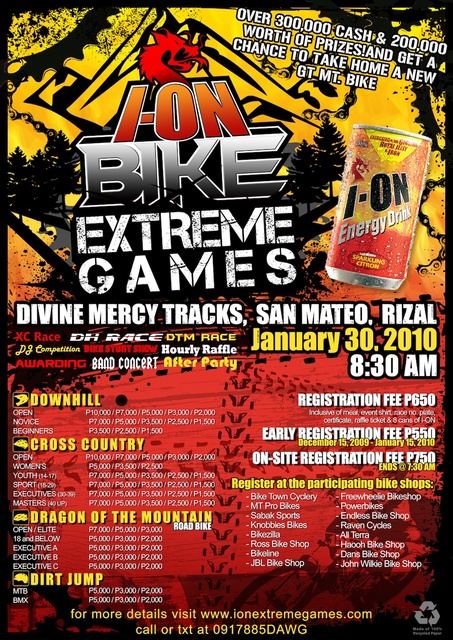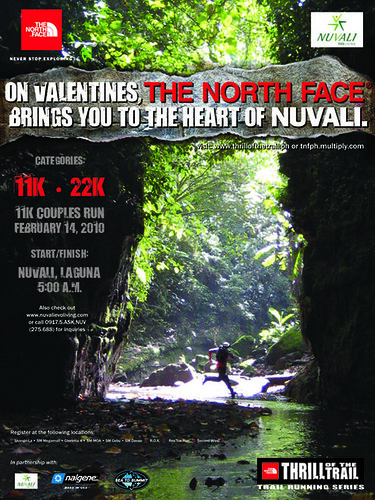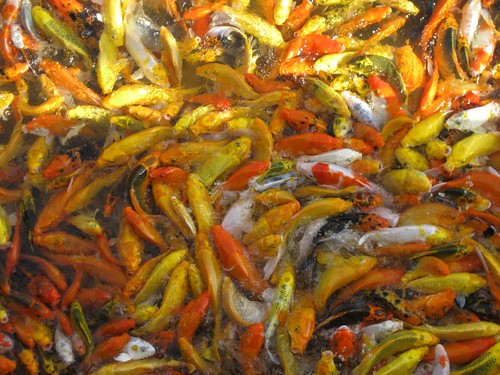Written on 3:02 AM by yahoo

delivers the latest breaking news and info
I-ON Energy Drink together with Divine Mercy Track in San Mateo, Rizal will be organizing a mountain bike event on January 30, 2010.
Registration Fee is P650, which includes a meal, event t-shirt, raffle ticket and 8 cans of I-ON energy drink!
Early registration fee is P550 between December 15, 2009 to January 15, 2010.
An onsite registration is also available on the event day for P750 and it ends at 7:30AM, so be sure to be there early
There will be a band concert after the competition.
Register at your nearest participating Bikeshops. For more details visit www.ionextremegames.com or call 0917-885DAWG.

Posted in
bike. mountain bike,
mountian bike,
Race
|

Written on 1:20 AM by yahoo
TNF is always a race anticipated by runners seeking new adventures in the world of running। It offers a unique experience from the typical road race and away from the concrete jungle of Manila। Past races were at Clark, Legaspi, Cagayan de Oro, and now it’ll be at Nuvali, Sta. Rosa, Laguna. (Click HERE to read my TNF 100 Race Report last May 2009, Clark)

delivers the latest breaking news and info
TNF RACE DETAILS
* Date: February 14, 2010, Sunday
* Start: Nuvali, Laguna, 5:00 a.m.
* Distance: 11k | 22k | 11k couples trail run. Partners should arrive at the finish line at the same time.
* Fee: P450 per person
* Register at R.O.X., Second Wind, Res Toe Run, The North Face – Shangrila, Glorietta, SM MOA, SM Cebu, SM Davao
* Contact: 0917.5.ASK.NUV (275.688)
* Website: www.nuvalievoliving.com
NUVALI
TNF at Nuvali makes the race doubly exciting for me. I was just at Nuvali last month for our TBR Magazine shoot with Ani de Leon. I was delighted to discover this shangrila in the south developed by Ayala Land, which will be home to many families and offices in the future. It was beautiful there; the atmosphere was calm and serene, the air fresh, and the roads beckoned for us to run on them. They say the grand plan is to provide many outdoor activities in this area, such as trail running, mountain biking, ziplining, and in the future, an area for triathlons to be staged.

NUVALI TRAIL RUN COURSE – There’s a flexible trail run course from 11k, 22k, up to 50k. There are natural river trails on 2 areas with 1km section each: one even has a waterfall.



fishy fishy KOI

Posted in
Race,
road running,
run,
TNF 100,
trail running
|

Written on 8:50 PM by yahoo

delivers the latest breaking news and info
It's the feast of the Black Nazarene where thousands of devotees and a handful of uzis, vendors, and journalists flock to Quiapo to celebrate what has become the biggest procession in the country.
Here's a quick explainer so that we don't go into this in blind faith.
What is the Black Nazarene?
If you absolutely have no idea what it is, you should be ashamed of calling yourself a Filipino. The Black Nazarene is a life-sized wooden sculpture of Jesus Christ, carved by an unknown Mexican carpenter.
It is the centerpiece of the largest annual procession in the Philippines, held in Quiapo Manila every January 9, which attracts thousands upon thousands of pious devotees.
The statue’s trip to the Philippines was a long one, coming all the way from Mexico in a Spanish galleon. Today, the Black Nazarene can be found at the Minor Basilica of the Black Nazarene (a.k.a. Quiapo Church) in Quiapo, Manila.
Why is it black?
Brought by the Augustinian Recollect Missionaries to the Philippines in the 1600s, the Black Nazarene was originally not black. Like most other religious images produced in that era, it was originally white.
During the trip to the Philippines though, the ship caught fire, burning the image, though not totally destroying it. Taken as some sort of miracle, the people sought to preserve it, and it is said today that touching the revered image results in miracles.
It's the Feast of the Black Nazarene
WORDS BY: GELO GONZALES
ILLUSTRATION BY: FRANTZ ARNO SALVADOR
January 8, 2010
Nearly half a millennium and the Black Nazarene still lives?
The Black Nazarene is a powerful icon, and is obviously well taken care of.
But what’s miraculous is that it has survived several other disasters, like when the Quiapo Church was burned down in 1791 and 1921. In 1791 and 1921.
The image was also unharmed when massive earthquakes shook the church in 1645 and 1863. Even with the bombing of Manila during World War II, the holy image was spared. Divine intervention? We believe so.
But the Black Nazarene wasn’t so lucky to avoid a gunshot in the 90s, leaving its left cheek damaged.
Today, in order to preserve the original statue, the head and the cross of the Black Nazarene are left behind at the shrine during the parade. Replicas of the head and the cross along with original body are used.
When did the devotion for the Black Nazarene start?
Since the image was brought to Philippine shores on May 10 1606, the Black Nazarene had been much revered, partly due to the fact that it survived a fire.
It was first enshrined in the first church of the Recoletos in San Juan de Bagong Bayan (Bagumbayan). Two years later, it was transferred to a bigger church of San Nicolas de Tolentino inside the walled city, Intramuros.
January 9, 1787 was another significant date in the Black Nazarene’s life because this was when it was transferred to Saint John the Baptist Church, otherwise known as the Minor Basilica of the Black Nazarene.
The transfer of the image was ordered by the Archbishop of Manila, Basilio Sancho de Santas Justa y Rufina, and it was then that the number of devotees burgeoned. The intense devotion towards the Black Nazarene has never wavered since.
It's the Feast of the Black Nazarene
WORDS BY: GELO GONZALES
ILLUSTRATION BY: FRANTZ ARNO SALVADOR
January 8, 2010
The date of the transfer is also the reason the Feast of the Most Holy Black Nazarene is celebrated every January 9.
How does one show devotion to the Black Nazarene?
If you’ve decided that you want to make a panata to the Black Nazarene, and you’re sure that you can handle the massive waves of people hammering you from all sides during the procession itself, you better know some of the religious rituals that people do to show devotion.
First, most people make it a point to go barefoot during the whole procession, as a symbol of humility, and to imitate Christ’s barefoot journey to his crucifixion at Mount Calvary.
Next, there’s the pahalik. That's when people wait for their chance to plant a kiss on the Nazarene’s foot, as a sign of respect.
Pabihis involves the dressing of the image up for major events, which is normally done five times a year. Next, pasindi is simply the lighting of the candles in the Minor Basilica of the Black Nazarene, which are accompanied with your own prayer intentions.
Last is bendisyon where people catch the droplets of holy water from the priest. Simple, right?
What goes on in the actual procession?
As the door of the church opens, and the Black Nazarene proceeds to move on a caroza for all to see, the devotees begin to shout “Viva Senor!” (Long live the King!) while waving white towels in the air.
Participants garbed in red proceed to pull the two ropes connected to the carriage, and the procession begins. The huge throngs of people and devotees seek to at least touch the holy image, and wipe it with their handkerchiefs, the result of which is utter chaos.
This is the reason the procession becomes so frenetic. Some people are also tasked to guard the image from overzealous devotees who might cause damage.
If you plan to join, make sure you’re fit enough to handle the stress, and even then, there are real dangers of being injured or crushed to death. So be careful. In any case, the event is a spectacle to witness, and is also a tourist attraction to a certain extent.

Posted in
feast,
latest news,
news
|


![]()








